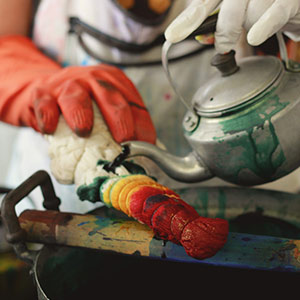Shibori, Batik and Ombre – dyeing techniques for fabrics and textiles
Batik with wax – How to dye a table runner
"Mbatik" means "write with wax" in Javanese. With a special wax pot on a stick (tjangting), which works like a fountain pen, liquid wax is applied to the fabric in the form of lines and patterns. This is where no color will adhere when dyeing the fabric.
Instructions: With help of a template and a pencil circles or stars or any other pattern are drawn onto the table runner. These areas are then painted with liquid wax of tea lights. A cardboard underneath prevents wax from penetrating the table. After dyeing and drying the table runner, the wax residues are covered with kitchen paper and soaked up with a hot iron.
Batik with help of bindings – dyeing a shirt with circle patterns
In this case the patterns are achieved with help of firm bindings in the fabric. This dyeing technique is well known for its circle patterns, which appear again and again in the fashion world.
Instructions: The shirt is laid flat. Mark the center point of a desired circle pattern with a pin. Lift the shirt up from there and smooth it down. One or more bindings are now made with package cord. After dyeing and drying the textiles, remove the cords.
Fine Shibori patterns – dyeing a cushion cover
The Shibori technique from Japan is a special batik technique among the dyeing techniques. Fine and clearly defined embellishments are dyed. The fabrics are first folded in accordion-like manner. In addition, the folded fabric can be rolled up. The batik bindings are applied around the folded fabric.
Instructions: Fold the pillow cover in about five centimeters wide accordion-pleats. Then tie the folded fabric at several points with help of a cord. After dyeing and drying, remove the Shibori bindings.
Color shading with the Ombre method – dyeing a tunic
With the Ombre method, fabrics or textiles are provided with different shades of one color. Ombre is an uncomplicated method among dyeing techniques.
Instructions: The tunic is dipped to three quarters into a dye bath. As soon as a bright color tone is reached, the fabric is pulled up. Then the tunic is dipped into the dye bath only halfway until a slightly stronger color is reached. In the last step the tunic is immersed only to a quarter to obtain the darkest shade.
Colors, dye quantity and dyeing instructions
LIVOS offers the skin-friendly and environmentally friendly WEJA textile paints made of renewable raw materials, for fabrics and textiles made from animal fibers (wool and silk) and from vegetable fibers (cotton, linen, hemp). Color charts and detailed dyeing instructions with information on the dye quantity and the corresponding fabric weights provide information on how to dye in the washing machine or in a pot. If you have any questions, please contact the LIVOS team by phone or by mail.


